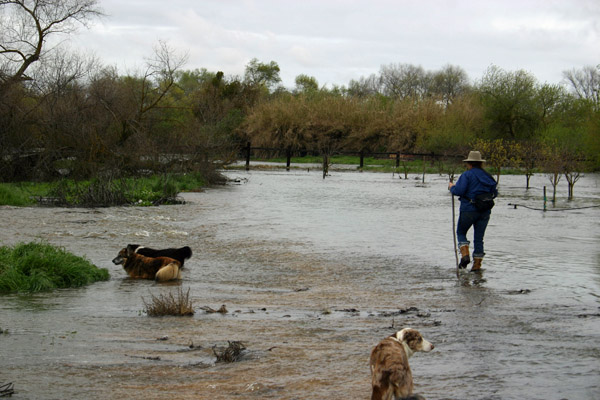 By Joel Hastings
By Joel Hastings
The Madera Irrigation District and GSA held a special board of directors meeting on May 7, 2020 using the ubiquitous Zoom technology and telephone conference line, with the Governor’s stay-in- place directive still in effect. A key item of business for MID was to determine the timing, amounts and rates for MID water distribution this season. More on that below. A technology note: this was the best Zoom meeting I’ve been on for clarity, organization and proper use of the technology.
The meeting was opened by General Manager Tommy Greci at 1 p.m. with the Board moving directly into executive session to conference with legal counsel on two anticipated and three existing items of litigation.
The open meeting began at 2 p.m. with President Jim Erickson calling the session to order. There was nothing to report from the closed session. He invited public comment but none was forthcoming so Andrea Sandoval, Executive Assistant, read the ground rules for the use of technology for this meeting.
The meeting of the MID GAS was opened with updates from Dina Nolan, MID Assistant General Manager. Notable was her announcement that a mediation session has been set for June 12 among six of GSAs in the Madera Subbasin and the New Stone Water District GSA over the issue of a coordinating agreement required for the GSAs in the subbasin. Some will remember that New Stone was bargaining for more water in exchange for signing the coordinating agreement which SGMA requires when there are more than one GSA in a subbasin. When New Stone refused to sign, that put the whole subbasin out of compliance with SGMA at the Jan. 31 deadline and potentially cost the Madera County a $500,000 state grant.
The MID Board was reconvened with approval of the consent agenda which included meeting minutes and approval of bill payments, financial reports and some additional HR policies. A roll call vote was taken with unanimous support. (Because the board members were on Zoom and not together, every vote required a roll call.)
Then Greci delivered his General Manager’s report, saying the COVID-19 guidelines for protecting employees and the public have been fully implemented. Staff is in the office in shifts allowing social distancing. MID has provided masks for staff and the office is closed to the public. Operations department is taking water signups electronically with an invitation to call in. He says the public’s patience is appreciated.
Last year the 401K retirement plan was out of compliance with IRS regulations. The plan has been converted to a 401A program, appropriate for public agencies with subsequent notification that now all is in order.
He reported that the generator at the Friant Public Power Authority had been rebalanced and realigned with the flywheel spinning better than when it was new, satisfactorily producing power.
As noted above, the most important agenda item concerned the supply, allocation and pricing of water for the 2020 cropping season. On the supply side, he said the Bureau of Reclamation has been upping their estimates, but he said that only 55% of the Class 1 allocation would be available, amounting to 46,750 AF (acre feet), low by historic standards. The full 100% allocation of Class 1 water for MID amounts to 85,000 AF. There have been 30,000 AF allocated from Hensley Lake for riparian use. Overall, it appears it will be a very dry year with limited supplies available.
Since revenue principally comes from water sales, he said the staff have reviewed budget expenditures for all potential savings. And he’s hoping to have a water season beginning in late May running through to early August, with the possibility of some increased declarations from the Bureau.
He said he’s working to pursue water supplies for subordinate growers, but the prices are already high. With SGMA now in underway, many more are looking to purchase and acquire more water, rather than sell it. He and the staff have run sample budgets from worst case to best case with water supplies.
Cutting to the chase, regarding price he thought the low end with some additional water might be $95 to $100 AF and up to $150 AF for original district growers. Additional water for the subordinated growers will need to be at least $300 plus expenses. “These are the bookends… high and low,” he said.
Assistant Manager Dina Nolan commented, agreeing with Greci. “We think we can go closer to the $100 range. She said she’s looking forward to a water season that allows supply during the critical months for irrigation.
After the staff presentations, each of the five directors offered his thoughts for pricing for original lands and the subordinate acres. Thoughts ranged from $95 to $125 for original and up to $350 to even $375 for subordinate with pros and cons considered.
Nolan reminded the group that throughout the season rates can be adjusted reflecting supplies and “We’ll have another meeting on June 16 and we may have a better idea of what supplies look like.” She added, “We are always cognizant of keeping an eye on the expense budget.” Greci agreed the Board can revisit subordinate water pricing as conditions change.
After more discussion, the group set the rates with the water order form presented to everyone online. Each rate was arrived at by discussion and consensus in a very straightforward way:
Original district = $110 per AF
Operational Management = $110 per AF (there won’t be much in this dry year)
Subordinate lands = $375 per AF
Construction = $400 per day, increased from $300 per day
(Nolan explained that water trucks rarely use more than 3 AF per day and their use is monitored.)
Additionally,
District conveyance for water in the district = $60 per AF
District conveyance outside the district = $160 per AF
Payment dates for water are set for the last day of month with 2% late penalty
Assistant Manager Nolan commented that at these prices, staff predicts a $2 million budget shortfall but that’s with no new refinements and no new water. The consensus seemed to be that this was reasonable in a dry year with their fund balance in mind.
Director Rick Cosyns moved to approve seconded by Dave Loquaci with a unanimous roll call.
Several routine items of business were presented and approved next, including the opening of an account for credit cards at Umpqua Bank. It seems Bank of America no longer allows a special districts association – an agency like MID – to have cards for travel and vendor purchasing.
Two items with Madera County were approved. The dates of June 16 and 19 were set for the board of equalization meetings to include MID and the county will be reimbursed for MID director elections to be coordinated on Nov. 3 election day. Three MID district seats will be included.
A 3:00 p.m. appointment had been set for auditor Kip Hudson to join the call. His firm – Hudson, Henderson & Co., Fresno – had prepared the financial statements and audit for the year ending Dec. 31, 2019. He was complimentary of the staff work led by interim  controller Jennifer Furstenberg. He said his firm issued its report on Apr. 20 with a clean “unmodified” opinion, meaning of course, the financial house is in order with no material weaknesses and satisfactory controls.
controller Jennifer Furstenberg. He said his firm issued its report on Apr. 20 with a clean “unmodified” opinion, meaning of course, the financial house is in order with no material weaknesses and satisfactory controls.
He reviewed the income, balance sheet and cash flow statements. The 2019 ending net position was about $50 million, with $34 million unrestricted. That’s a net increase of $13.2 million, made up largely of water sales. Operating costs were reduced by $2.8 million from the previous year.
With this his first year of working with MID, he thanked the Board for the opportunity and his report was passed unanimously. While his work was praised, there was a suggestion, greeted with a chuckle, that several of his pie charts would benefit from larger type
For a several years there has been close cooperation between MID and the Madera-Chowchilla Water & Power Authority. With the retirement of a staff member at MAPOCO, a well-regarded fellow whose name I did not catch, it is being proposed that those management duties be transferred to MID staff. General Manager Greci recommends that a documented agreement be developed which would define responsibilities, authority and compensation for MID. The MID board approved the concept and will be able to approve the final contract on July 15 after action by MACOPA.
The board approved the creation of an Ad Hoc Strategic Planning Committee to give guidance to staff. Dave Loquaci volunteered for this job as did Director Carl Janzen. It was noted that MID president Jim Erickson is in line to become president of the Friant Water Authority, a potentially time-consuming task.
The Board also approved a one-year bridge agreement, to explore a permanent settlement to rationalize the boundaries between MID and the Madera Water District with a bit of acreage from each lying in the other entity.
Next meeting was set for June 19 with adjournment at 3:30 p.m.
DISCLAIMER OF RESPONSIBILITY; Waterwrights strives to provide clients with the most complete, up-to-date, and accurate information available. Nevertheless, Waterwrights does not serve as a guarantor of the accuracy or completeness of the information provided, and specifically disclaims any and all responsibility for information that is not accurate, up-to-date, or complete. Waterwrights’ clients therefore rely on the accuracy, completeness and timeliness of information from Waterwrights entirely at their own risk. The opinions expressed in this report are those of the author and do not represent any advertisers or third parties.
In addition to providing coverage for WaterWrights.net Joel Hastings is the editor and  publisher of Dairy Business. You can contact Joel at: jhastings@dairybusiness.com
publisher of Dairy Business. You can contact Joel at: jhastings@dairybusiness.com
ALL RIGHTS RESERVED. Copyright 2020 by WaterWrights.net
Madera Irrigation District – 12152 Road 28 ¼ Madera, CA 93637 559/673-3514
Staff: General Manager -Thomas Greci, Assistant GM – Dina Nolan
Board: Dave Loquaci, Rick Cosyns, Brian Davis, Jim Erickson and Carl Janzen
HISTORY: From www.madera-id.org The Madera Irrigation District (MID or District) encompasses an area of approximately 139,665 acres. MID operates a primarily gravity irrigation distribution system with approximately 300 miles of open flow canal systems as well as 150 miles of large diameter pipelines.
The District has a Central Valley Project (CVP) repayment contract with United States Bureau of Reclamation (USBR) providing up to 85,000 acre feet (AF) of Class 1 and 186,000 AF of Class 2 water per year from the Friant Division (Millerton Lake). The CVP water is released from Millerton Lake through the Friant Dam, and then conveyed through the Madera Canal for delivery into the District’s service area. The District also entered into a CVP repayment contract with the USBR for the yield from the Hidden Unit (Hensley Lake). Under the Hidden Unit contract, the average annual supply available to the District is approximately 24,000 AF per year.
DWR SGMA # 5-022.06






























